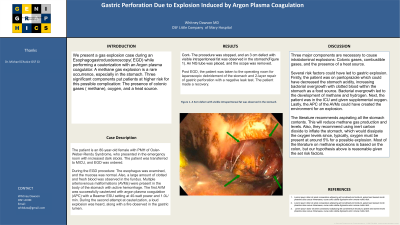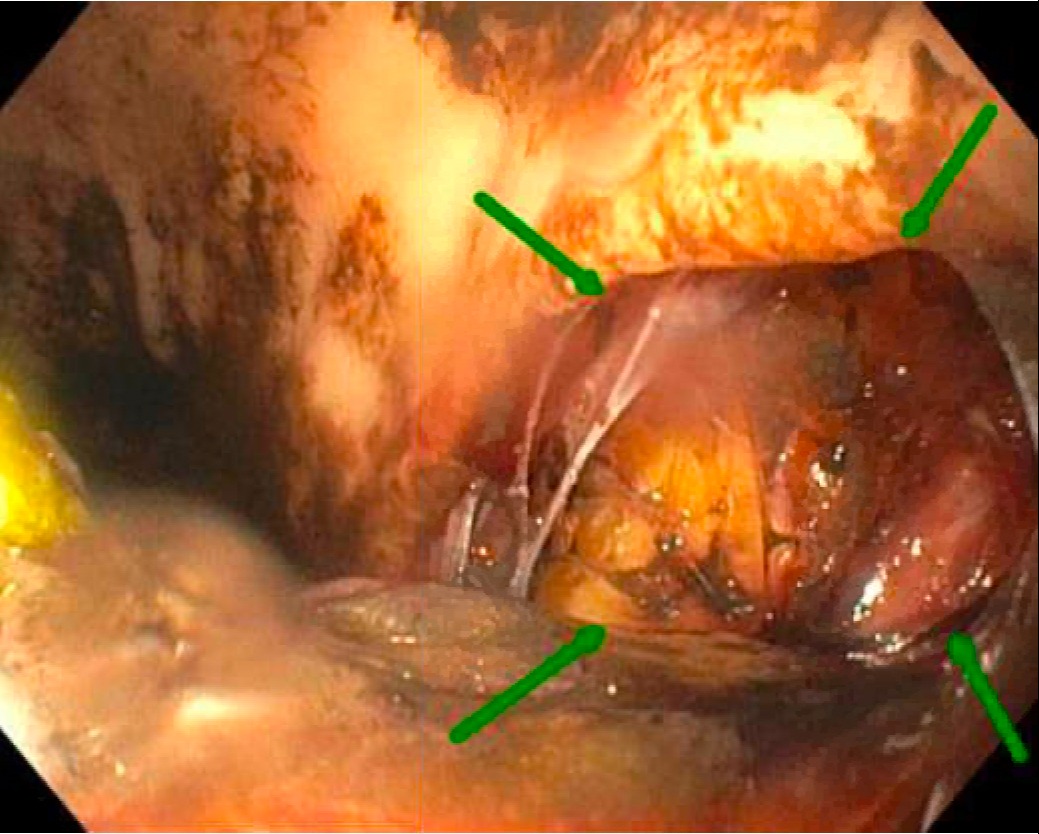Sunday Poster Session
Category: GI Bleeding
P0659 - Gastric Perforation Due to Explosion Induced by Argon Plasma Coagulation
Sunday, October 22, 2023
3:30 PM - 7:00 PM PT
Location: Exhibit Hall

Has Audio

Whitney Dawson, MD
OSF Little Company of Mary Hospital
Chicago, IL
Presenting Author(s)
Award: Presidential Poster Award
Whitney Dawson, MD
OSF Little Company of Mary Hospital, Chicago, IL
Introduction: We present a gas explosion case during an Esophagogastroduodenoscopy( EGD) while performing a cauterization with an Argon plasma coagulator. A methane gas explosion is a rare occurrence, especially in the stomach. Three significant components put patients at higher risk for this possible complication: The presence of colonic gases ( methane), oxygen, and a heat source.
Case Description/Methods: The patient is an 80-year-old female with PMH of Osler-Weber-Rendu Syndrome, who presented in the emergency room with increased dark stools. The patient was transferred to MICU, and EGD was ordered.
During the EGD procedure: The esophagus was examined, and the mucosa was normal. Also, a large amount of clotted and fresh blood was observed in the fundus. Multiple arteriovenous malformations (AVMs) were present in the body of the stomach with active hemorrhage. The first AVM was successfully cauterized with argon plasma coagulation (APC) with a Beamer ESU setting at 40-watt power and 1.0L/min. During the second attempt at cauterization, a loud explosion was heard, along with a fire observed in the gastric lumen. The procedure was stopped, and an 3 cm defect with visible intraperitoneal fat was observed in the stomach(Figure 1). An NG tube was placed, and the scope was removed.
Post EGD, the patient was taken to the operating room for laparoscopic debridement of the stomach and 2-layer repair of gastric perforation with a negative leak test. The patient made a recovery.
Discussion: Three major components are necessary to cause intrabdominal explosions: Colonic gases, combustible gases, and the presence of a heat source.
Several risk factors could have led to gastric explosion. Firstly, the patient was on pantoprazole which could have decreased the stomach acidity, increasing bacterial overgrowth with clotted blood within the stomach as a food source. Bacterial overgrowth led to the development of methane and hydrogen. Next, the patient was in the ICU and given supplemental oxygen. Lastly, the APC of the AVMs could have created the environment for an explosion.
The literature recommends aspirating all the stomach contents. This will reduce methane gas production and levels. Also, they recommend using inert carbon dioxide to inflate the stomach, which would dissipate the oxygen levels since, typically, oxygen must be present at around 5% for a possible explosion. Most of the literature on methane explosions is based on the colon, but our hypothesis above is reasonable given the set risk factors.

Disclosures:
Whitney Dawson, MD. P0659 - Gastric Perforation Due to Explosion Induced by Argon Plasma Coagulation, ACG 2023 Annual Scientific Meeting Abstracts. Vancouver, BC, Canada: American College of Gastroenterology.
Whitney Dawson, MD
OSF Little Company of Mary Hospital, Chicago, IL
Introduction: We present a gas explosion case during an Esophagogastroduodenoscopy( EGD) while performing a cauterization with an Argon plasma coagulator. A methane gas explosion is a rare occurrence, especially in the stomach. Three significant components put patients at higher risk for this possible complication: The presence of colonic gases ( methane), oxygen, and a heat source.
Case Description/Methods: The patient is an 80-year-old female with PMH of Osler-Weber-Rendu Syndrome, who presented in the emergency room with increased dark stools. The patient was transferred to MICU, and EGD was ordered.
During the EGD procedure: The esophagus was examined, and the mucosa was normal. Also, a large amount of clotted and fresh blood was observed in the fundus. Multiple arteriovenous malformations (AVMs) were present in the body of the stomach with active hemorrhage. The first AVM was successfully cauterized with argon plasma coagulation (APC) with a Beamer ESU setting at 40-watt power and 1.0L/min. During the second attempt at cauterization, a loud explosion was heard, along with a fire observed in the gastric lumen. The procedure was stopped, and an 3 cm defect with visible intraperitoneal fat was observed in the stomach(Figure 1). An NG tube was placed, and the scope was removed.
Post EGD, the patient was taken to the operating room for laparoscopic debridement of the stomach and 2-layer repair of gastric perforation with a negative leak test. The patient made a recovery.
Discussion: Three major components are necessary to cause intrabdominal explosions: Colonic gases, combustible gases, and the presence of a heat source.
Several risk factors could have led to gastric explosion. Firstly, the patient was on pantoprazole which could have decreased the stomach acidity, increasing bacterial overgrowth with clotted blood within the stomach as a food source. Bacterial overgrowth led to the development of methane and hydrogen. Next, the patient was in the ICU and given supplemental oxygen. Lastly, the APC of the AVMs could have created the environment for an explosion.
The literature recommends aspirating all the stomach contents. This will reduce methane gas production and levels. Also, they recommend using inert carbon dioxide to inflate the stomach, which would dissipate the oxygen levels since, typically, oxygen must be present at around 5% for a possible explosion. Most of the literature on methane explosions is based on the colon, but our hypothesis above is reasonable given the set risk factors.

Figure: A 3 cm defect with visible intraperitoneal fat was observed in the stomach
Disclosures:
Whitney Dawson indicated no relevant financial relationships.
Whitney Dawson, MD. P0659 - Gastric Perforation Due to Explosion Induced by Argon Plasma Coagulation, ACG 2023 Annual Scientific Meeting Abstracts. Vancouver, BC, Canada: American College of Gastroenterology.

